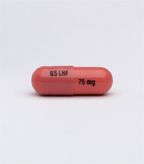ASCO: Dabrafenib Shows Activity in BRAF-Mutated NSCLC Patients
Interim results of a small phase II study found a relatively good response rate with dabrafenib in BRAF V600E mutation-positive stage IV non-small-cell lung cancer (NSCLC) patients. The results were presented at ASCO.
Interim results of a small phase II study found a relatively good response rate with dabrafenib in BRAF V600E mutation–positive stage IV non–small-cell lung cancer (NSCLC) patients. The results were presented at the annual meeting of the American Society of Clinical Oncology in Chicago.

Dabrafenib, 75 mg
Dabrafenib is a reversible, small molecular BRAF inhibitor, and has shown strong clinical efficacy in BRAF-mutant melanoma, leading to US Food and Drug Administration approval last month in that setting. David Planchard, MD, PhD, of Institut Gustave-Roussy in Villejuif, France, presented the new study in NSCLC and said the drug is highly specific for the BRAF mutant V600E. This is a relatively rare mutation: BRAF mutations were found in 1.6% of all NSCLC patients in a large French study, and V600E accounts for about half of those mutations.
The new study was a single arm, phase II, open label trial with an interim analysis planned after 20 patients. The results presented included 20 patients evaluated for efficacy and 25 for safety. All patients had the V600E mutation and had progressed after at least one prior line of therapy; they received dabrafenib at a dose of 150 mg twice daily.
The investigators found no complete responses among the 20 patients; there were 8 patients (40%) with a partial response, 4 patients (20%) with stable disease, 6 patients (30%) with progressive disease, and 2 patients (10%) were not evaluable. Thus, the response rate, which was the primary objective of the study, was 40%, and the disease control rate (complete and partial responses along withs table disease) was 60%.
The median duration of treatment was 84 days (range, 9 to 480 days), though Dr. Planchard pointed out that 12 patients (48%) were still on the study treatment at data cutoff. Thirteen had discontinued treatment: 10 because of disease progression, two because of an adverse event, and one by patient decision.
Almost all the patients (96%) reported at least one adverse event with dabrafenib, with fatigue as the most common; 44% had a grade 3 adverse event, and 92% of patients had an adverse event that was related to the study treatment.
“Dabrafenib shows promising clinical activity for patients with metastatic BRAF V600E-mutated NSCLC,” Dr. Planchard concluded. He noted that the study has expanded its sample size and now is allowing enrollment of first-line patients.
Pasi A. Jnne, MD, PhD, of the Dana Farber Cancer Institute in Boston, was the discussant for the session and noted that with rare mutations it becomes harder and harder to get effective drugs approved. “The real challenge we have as a community is that randomized trials vs chemotherapy may not be feasible due to the size of the patient population,” he said. Developing unique protocols and trial designs can help with this issue, including ideas like a platform trial where multiple study arms can accrue in parallel, allowing rare genotypes to be studied.
“I think we need to think about novel ways in which we can get these agents approved, because we’re seeing exciting activity in rare genotypes and we don’t want to not have these agents available for our patients,” Dr. Jnne said.